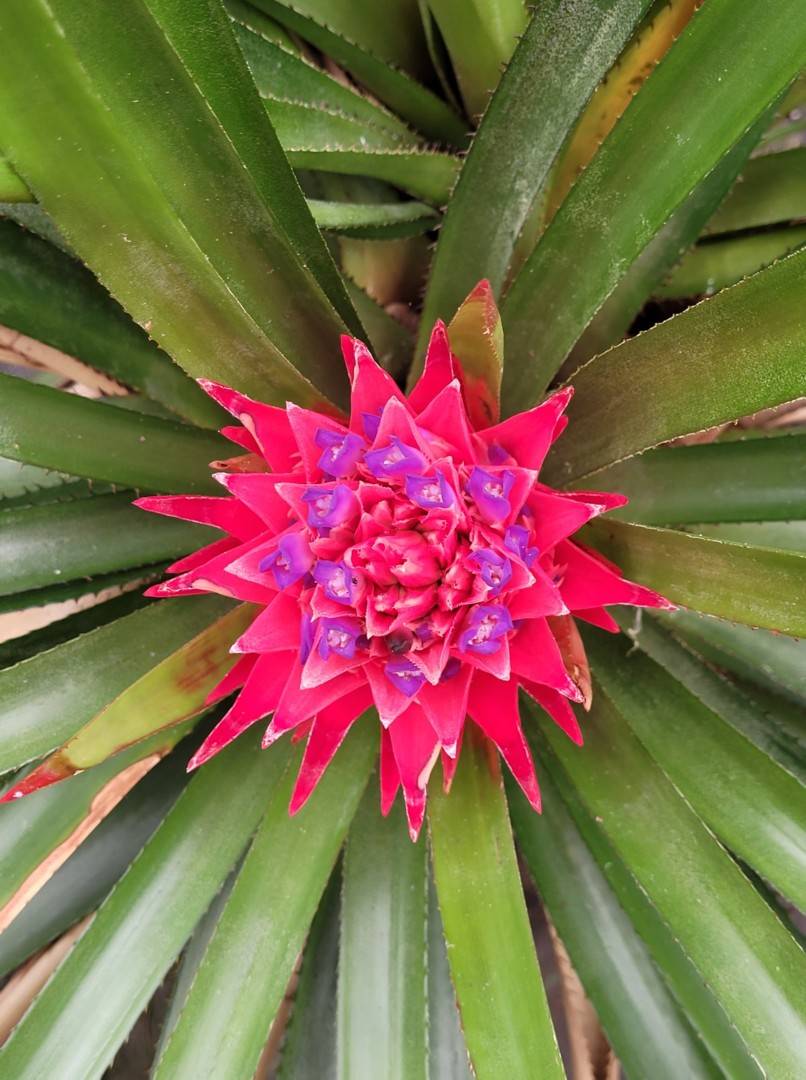

Aechmea skotakii H. Luther ined, nom. provis.
Desc from Broms of Ecuador Manzanares 162-3. 2002
PLANT flowering 40 cm tall, 100 cm wide, stolons pendent, rosette campanulate.
LEAVES dense and numerous.
SHEATHS 12 cm long, 10 cm wide, oblong, coriaceous, margins hyaline white and upper part with spines, lepidote, brown castaneous abaxially.
BLADES 52 cm long, 3.5 cm wide, margins serrate with castaneous brown spines 1.5-5 cm long and 5 mm apart, lingulate, coriaceous, apex acuminate, punctulate lepidote.
INFLORESCENCE 12 cm long, 10 cm wide, branched, with 50-60 spikes, dense, capitate, red, punctulate lepidote.
PEDUNCLE submerged in center of rosette, 8 cm long, 8 mm in diameter.
PEDUNCLE-BRACTS the lower foliaceous and lingulate , 7-15 cm long, 3 cm wide, apex acuminate, margins sheathing part entire and blade serrate, red, punctulate lepidote, remote.
PRIMARY BRACTS erect, imbricate, coriaceous, sheathing part ovate and blade triangular, the lower bracts as the peduncle-bracts, 5 cm long, 3 cm wide, exceeding the spike and completely covering the spike, apices incurved acuminate, white lepidote and glabrous, red.
SPIKE short pedunculate, 4cm long, 2cm wide, fasciculate, with 2-3 distichous flowers.
FLORAL BRACTS 32 mm long, 18 mm wide, ovate, apex apiculate, margins sparsely serrate toward apex, carinate, glabrous, shorter than the sepals, erect, pink.
FLOWERS sub-sessile, blue.
SEPALS 24 mm long, 6 mm wide, triangular, coriaceous, asymmetrical, alate carinate, apex armed with a minute mucro, glabrous, pink.
PETALS 4 cm long, petal blade apex with sharp point; with two large appendages at the base,
STAMENS included, antesepalous stamens highly adnate to the petals. Filaments 2.8cm long, white and flat, Anthers 7mm long dorsifixed in center, anthers white;
PISTIL included 3 cm long, style white.
OVARY 10 mm long, obconic.
TYPE. Chester Skotak s.n. (holotype: SEL), province of Zamora Chinchipe, Ecuador, 1962.
ETYMOLOGY. Named in honor of Chester Skotak.
OBSERVATIONS This species is endemic to Ecuador. Because of its ornamental beauty, it has a high risk for survival. It can be confused with A. biflora, also endemic but with a geographic distribution in the province of Pastaza. There are two populations of A. skotakii, one in the Cordillera del Condor with a red inflorescence and the other in the Cordillera Oriental from Macas to Zamora with white to cream flowers.
MATERIAL EXAMINED. Morona Santiago: ascent to the volcano Sangay from San Isidro, Macas, 02°10'S 78°12’W, Jul. 1994, J.M. MANZANARES, K. BRACKE, PABLO, NELE & REBECA MANZANARES 5177 (QCNE); road Gualaquiza-San Juan Bosco, km 7,6, 1250 m, 29 Aug. 1996, J.M. MANZANARES, HUGO VAN DURME & PABLO MANZANARES 6169 (QCNE); collected by J. Kent & R. Deroose, between Chiguinda and Gualaquiza, 900 m, Aug. 1999, J.M. MANZANARES, J. KENT & R. DEROOSE 6723 (QCNE); Ijiach Naint (03°15'19"S 78°13 '56"W) 845 m, Cordillera del Huaracayo, 25 Mar. 2001, J.M. MANZANARES, B. PATTERSON & D. NEILL 7308 (MO, QCNE). Zamora Chinchipe: Nangaritza, Pachicutza, path to landmark, 04°07'S 78°37"W, 900 m, 18 Oct. 1991, W. PALACIOS, G. AYMARD & E. FREIRE 8248 (QCNE); road Los Encuentros to Destacamento, km 32,6, 78°36"W 03°49'S, 1606 m, 11 Apr. 1997, J .M. MANZANARES, E. GIRKO, J. RAACK, E. DOHERTY & M. NAVARRO 6345 (QCNE); collected on the road Los EncuentrosDestacaillento, km 32,6, 78°36’W 03°49'S, 1606 m, 11 Apr. 1997, flowering in cultivation, Jan. 2000, J.M. MANZANARES 6946 (QCNE); collected on the road Los Encuentros-Destacamento, km 32,6, 78°36’W 03°49'S, 1606 m, 11 Apr. 1997, flowering in cultivation, Jun. 2000, J.M. MANZANARES 7091 (QCNE).
DISTRIBUTION. Epiphyte in the montane rainforest of Amazonia.